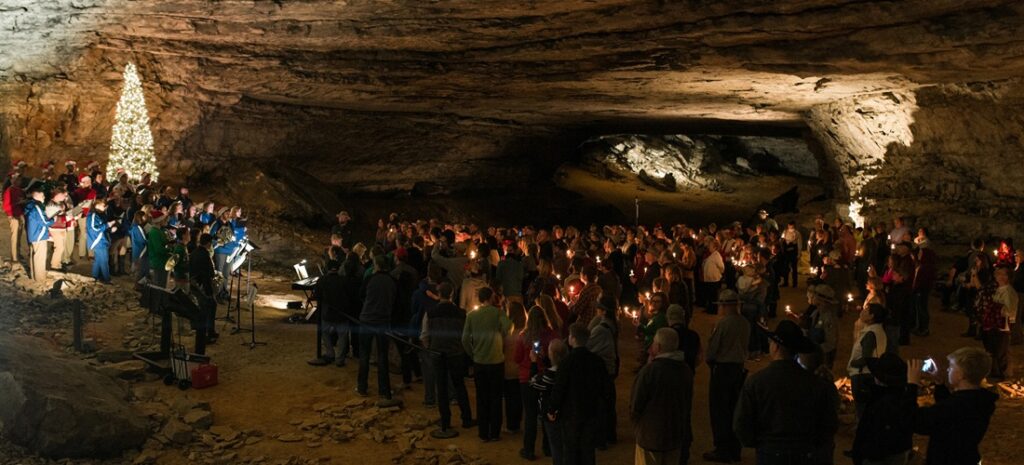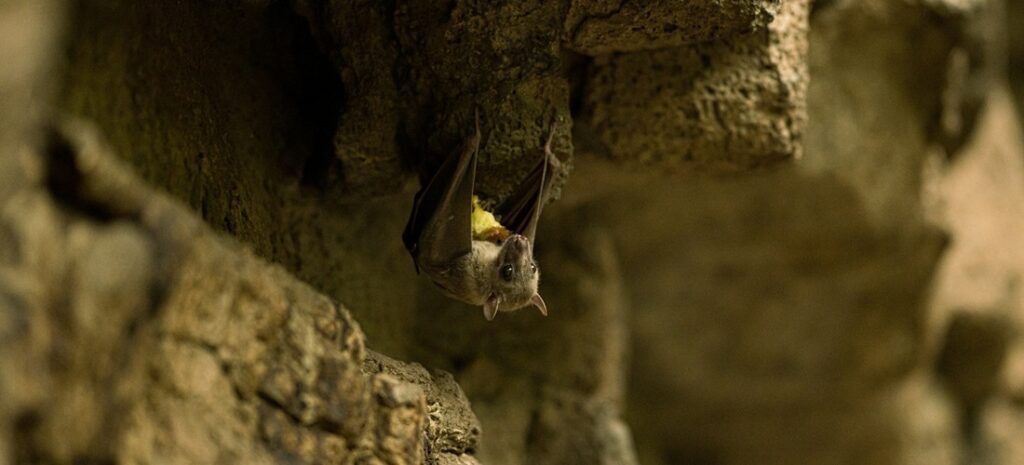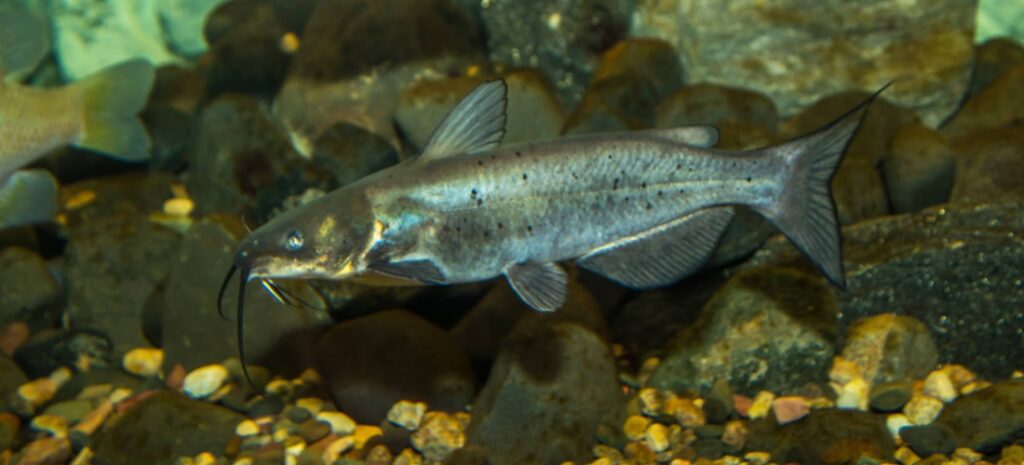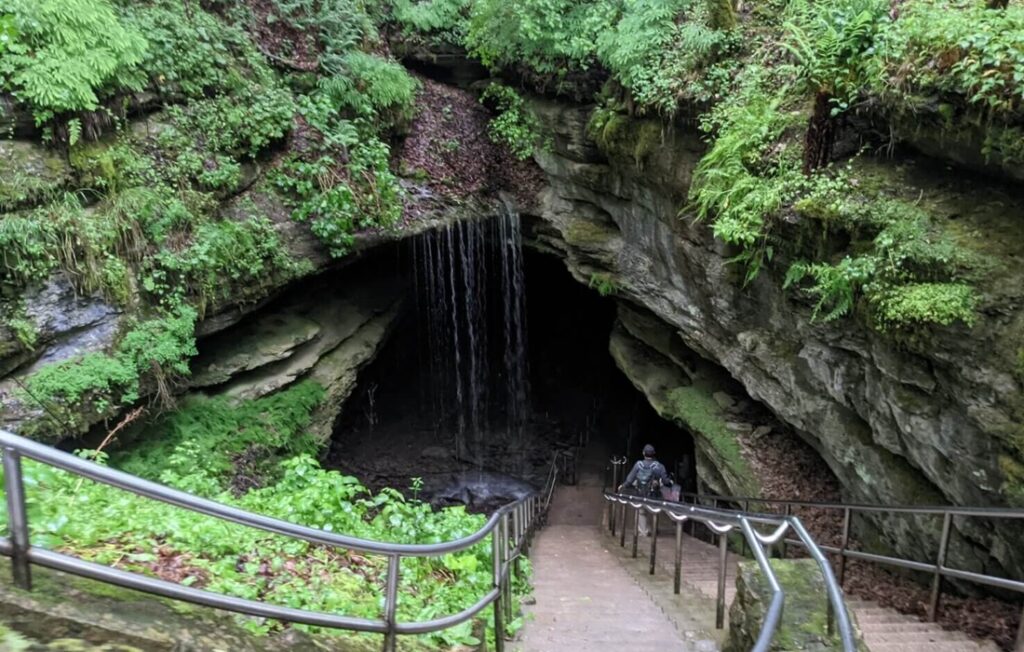Nestled into the steep, lush hills of western Kentucky, camouflaged against a backdrop of trees and moss-covered rocky outcrops, sits the yawning mouth of a cave. Despite its daunting size, it somehow seems to blend into the backdrop of the busy woodlands that surround it—chattering blue jays, squirrels wrestling in the underbrush and disturbing a flock of wild turkeys who squawk indignantly, the soft and happy burbling of a nearby creek, trees popping and settling under the weight of dense greenery, and the tap, tap, tap of industrious woodpeckers searching for grubs.
To reach the cave entrance, you descend a curving set of concrete stairs, lined by a shelf of limestone to your right, until you reach a walking path with a shallow pool of water on one side, not yet drained away from a heavy day of rain. The walls of the cave are grayish-brown limestone, cool and slightly damp to the touch, and when you shine a flashlight on the rock, it glitters, reflecting the many gypsum crystals embedded throughout the cave.
The farther you step into the cave, the darker it becomes, until artificial lights begin to appear around you, inviting you to continue exploring. Soon, you turn a corner and all natural light from the cave’s entrance blinks out of existence. The artificial lights illuminating the path before you are the only thing separating you from total, all-consuming darkness.
Welcome to Mammoth Cave.
Mammoth Cave National Park – Cave City, Kentucky
Mammoth Cave National Park is home to the world’s longest cave system, with 426 miles of explored tunnels and 500 other smaller caves also located on park property. Geologists have theorized that there could be as many as 600 miles of passageways yet to be discovered as part of this complex underground cave network.
Unsurprisingly, this fascinating piece of natural underground architecture has drawn attention from explorers, hunter gatherers, miners, businessmen, and curious visitors alike for thousands of years. Throughout history, the caves have acted as shelters, burial grounds, mines, a make-shift hospital, a hotel, a concert hall, a museum, a church, and a source of ecological marvel.

The first published use of the name “Mammoth Cave” occurred in a Virginia newspaper in 1810 after a European settler “discovered” it 20 years earlier in 1790, but uncovered artifacts throughout the cave system, including multiple sets of ancient human remains, showed regular use by Indigenous peoples as early as 5,000 BCE. Seven tribal nations are affiliated with the park’s lands: the Eastern Band of Cherokee Indians, Cherokee Nation, United Keetoowah Band of Cherokee Indians, Shawnee Tribe, Eastern Shawnee Tribe of Oklahoma, Absentee Shawnee Tribe, and the Chickasaw Nation.
When Mammoth Cave was formally established as a National Park in 1941, only 40 miles of passageways had been mapped. Since then, it has become home to 53,000 acres of protected forest and nearly 70 miles of groomed trails for visitors to explore aboveground in addition to guided tours of the cave passages, varying in difficulty from beginner-friendly to multi-hour, high endurance expeditions.
The cave system has also become renowned for its contributions to science and how we understand the natural world. Through studies of the cave and the roughly 130 unique species that live deep within its passages, scientists have come to gain invaluable insight into the role of caves, how these fascinating ecosystems work, and the vibrant ecosystems that exist in even the world’s darkest places.
The Formation and Ecosystem Services of Caves
Mammoth cave is a karst cave formation, created by the dislodging or eroding of rock (especially highly soluble rocks like limestone) by water moving through the local watershed (drainage basin), and it is estimated to have formed between one and 10 million years ago.
The slow process of cave creation enabled many species to adapt to life in the dark, feeding on other cave dwellers or organic matter carried in by water from the surface. While caves themselves are far from the most biodiverse habitats out there, they play a unique role in our understanding of biodiversity because their ecosystems tend to be very distinct from one another, often dependent on cave type and geographic location.
Species that play a role in cave ecosystems are broken down into three key categories:
Trogloxenes (“Visitors”): Species that come and go from the cave, most often using it for nesting, giving birth, or hibernating through the winter. (Examples: bats, bears, raccoons, moths, woodrats.)
Troglophiles (“Explorers”): These species are permanent cave residents who still venture outside from time to time, often seeking food or to mate. (Examples: crayfish, beetles, frogs, salamanders, crickets.)
Troglobites (“Hermits”): These permanent cave residents have fully adjusted to life in complete darkness; so much so that they cannot leave their specific underground habitats, making them endemic to a single cave. (Examples: cave fish, Kentucky cave shrimp, millipedes and other insects.)

CAVE ZONES
Similar to ocean habitats, scientists use subterranean “zones” to identify ecosystems at different depths and levels of darkness. (If you’ve read our blog on the deep sea, you might recognize some strong similarities.)
Entrance Zone – Where a subterranean cave meets surface habitat.
Twilight Zone – Light from the surface is diminished, but certain plant species can still grow.
Transition Zone – All light is completely diminished, but other environmental factors from the surface such as temperature and precipitation can still influence conditions here.
Deep Zone – No light, high humidity with low evaporation, and constant temperatures. Species living in the deep zone have fully adapted to life in these conditions and often display noticeable physical adaptations, such as cavefish (sometimes referred to as “ghost fish”).
To survive and thrive in these deeper cave zones, many species have developed unique adaptations—some of which are clear to the naked eye. The most well-known forms of adaptation (which have also been witnessed in the deep ocean) are lack of pigmentation and blindness. Some cave-dwelling fish species have so significantly adapted that they’re born without eyes altogether. After all, what’s the point of sight when you live in total darkness? Instead, these species rely on longer fins and whiskers to better feel the world around them.

Non-physical adaptations for cave species include decreased metabolism (slows growth, increases lifespan, requires less food, and produces fewer offspring), increased lipids (body stores more energy per piece of food), altered circadian rhythms that are not influenced or controlled by light, and a better sense of smell.
FRESHWATER, HABITATS, AND CULTURE
Many types of caves play a key role in freshwater ecosystems as well as ground and surface water replenishment. For instance, groundwater located in caves is known to feed into swamps, lakes, streams, and wetlands. Vegetation above and surrounding cave systems tap into this freshwater source for survival.
“Groundwater in these subterranean cave systems may support plant and/or animal communities, ecological processes and delivery of ecosystem services.”
Queensland Government (Australia)
Water from caves also contributes to aquifer systems (the storage of groundwater in permeable rock), estuarine habitats (partially enclosed areas of brackish water where freshwater bodies meet the ocean), and coastal marine ecosystems. Though largely unseen, caves play a pivotal role in maintaining healthy habitats across the globe. But that’s not where their role ends.
“In the constant cool temperature and high humidity of caves, chemical processes run more slowly and organic material does not decompose as quickly. In addition, the destructive influence of wind and weather and the rapid covering with sediments are missing. This is the reason why many finds of early humans are made in caves. By the way, dripstones even preserve information about the climate of past times.”
UNESCO Global Geopark
or millennia, caves have influenced human evolution and culture, both as shelter and as recordkeeper. Cave drawings date back tens of thousands of years (the earliest, a painting of a warty pig from Sulawesi, Indonesia is 45,000 years old). These paintings, along with numerous fossils and artifacts that have been uncovered throughout the years, help tell the story of humanity and what drives us, from hunting and gathering to worship to artistic expression.
Human Impacts on Cave Ecosystems
Even in the modern world, caves have been used for more than just their ecological benefits. Humans have been known to use them for storage, entertainment, dumping refuse, and mining resources. While not all of these actions may seem harmful on the surface, the influence of humans on these carefully regulated ecosystems can be significant.

The human body alone adds excess carbon dioxide and heat to the atmosphere, and, as surface-dwellers, we can transport foreign substances from the outside—chemicals, organic material, and non-native organisms—which can impact the overall health and efficiency of the cave’s ecosystem.
One of today’s most pressing examples of this impact is on the transference of the fungi species that causes white-nose syndrome in bats, which has led to mass die-offs of these mammals across North America. Humans entering and exiting caves can unknowingly carry these fungi with them, exposing new and highly vulnerable habitats to this disease and dramatically influencing the ecosystem’s health as a result.
Human activity, like pollution, is also incredibly harmful to cave ecosystems as toxic particulates in our air, water, and soils leach into groundwater.






